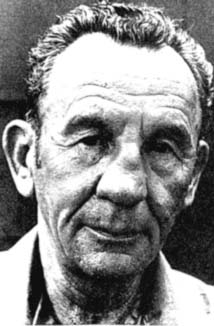


 تاريخ الرياضيات
تاريخ الرياضيات
 الرياضيات في الحضارات المختلفة
الرياضيات في الحضارات المختلفة 
 الرياضيات المتقطعة
الرياضيات المتقطعة
 الجبر
الجبر
 الهندسة
الهندسة 
 المعادلات التفاضلية و التكاملية
المعادلات التفاضلية و التكاملية 
 التحليل
التحليل
 علماء الرياضيات
علماء الرياضيات |
Read More
Date: 9-11-2017
Date: 3-11-2017
Date: 15-10-2017
|
Died: 5 July 1977 in Berkeley, California, USA

Henry Scheffé's parents were German but had emigrated to the United States and lived in New York. Henry's father was a baker by trade but lost his job during the depression and he was forced to sell apples on the street corner to save the family from starvation. It was a time of great suffering and [1]:-
... the memory of this injustice and of his father's suffering remained with Scheffé throughout his life.
Mathematics was not the first area to interest Scheffé and he began working as an engineer. However, he soon decided to go to university to study mathematics and took a course in pure mathematics at the University of Wisconsin, receiving his BA in 1931. He wrote a doctoral thesis on differential equations and was awarded his PhD in 1935. Before completing his doctoral studies he married Miriam Knott in 1934. They would have one daughter and one son.
Scheffé's doctoral dissertation The Asymptotic Solutions of Certain Linear Differential Equations in Which the Coefficient of the Parameter May Have a Zero was supervised by Rudolph E Langer. Immediately after completing his doctorate, Scheffé began a career as a university teacher and, having trained as a pure mathematician, it was naturally the subject which he taught. He was on the Faculty at the University of Wisconsin from 1935 to 1937, then spent three of the next four years at Oregon State University with the year 1939-40 spent at Reed College.
In 1941 Scheffé's interests moved from pure mathematics to statistics, and he joined Wilks at Princeton where a statistics team had grown up. Having retrained as a statistician, he began a second career as a university teacher, but this time he taught statistics rather than mathematics. He was on the Faculty at Syracuse in session 1944-45, and at University of California at Los Angeles from 1946 until 1948. Immediately after leaving Los Angeles he was appointed to Columbia University where he became chair of the statistics department.
After five years at Columbia, Scheffé went to Berkeley as professor of statistics in 1953. He was to remain at Berkeley for the rest of his life, retiring from his chair in 1974. He was chairman of department at Berkeley as he had been at Columbia University.
Scheffé, perhaps not surprisingly given his route into statistics, was interested in the more mathematical areas of statistics. He was particularly interested in optimal properties and he extended the Neyman-Pearson theory of best similar test.
His research was influenced by certain consultancy positions he held, such as one at the Office of Scientific Research and Development from 1943 to 1946. Later consultancy appointments were with the Consumer's Union and with Standard Oil.
After 1950 Scheffé's research was concerned with aspects of linear models, particularly the analysis of variance. One of his most important papers appeared in 1953 on the S-method of simultaneous confidence intervals for estimable functions in a subspace of the parameter space. Although he did not show the optimality of the S-method, this was proved by R A Wijsman in the late 1970s.
He also studied other aspects of analysis of variance such as paired comparisons which he studied in 1952, then mixed models studied two years later. In 1958 and again in 1963 he published on experiments on mixtures and in 1973 he wrote on calibration methods. His mixture designs were of fundamental importance and led to a major theory of mixtures being built later on Scheffé work.
A complete list of Scheffé's publications is given in [4]. His most important work was a comprehensive review of nonparametric statistics in 1943 and his book The Analysis of Variance (1959). Lehmann, who worked jointly with Scheffé on a general theory of similar tests, describes the book The Analysis of Variance in [1]:-
Its careful exposition of the different principal models, their analyses, and the performance of the procedures when the model assumptions do not hold is exemplary, and the book continues to be a standard text and reference.
Scheffé was in the middle of revising this book for a new edition when he died. He had retired from Berkeley and, following retirement, spent three years at the University of Indiana continuing his research work. Then, only a few weeks after his post at the University of Indiana had ended and he had returned to Berkeley, he was involved in a bicycle accident which resulted in his death.
Scheffé was elected to many statistical societies. He became a fellow of the Institute of Mathematical Statistics in 1944, the American Statistical Association in 1952 and the International Statistical Institute in 1964. He achieved high office in these organisations, being elected as president of the International Statistical Institute and vice president of the American Statistical Association.
In [1] Scheffé's interests outside mathematics and statistics are described:-
Throughout his life Scheffé enjoyed reading, music (as an adult he learned to play the recorder), and travelling. He was also physically active. At Wisconsin he was an intercollegiate wrestler, and he liked to cycle, swim, and backpack with his family.
Articles:



|
|
|
|
علامات بسيطة في جسدك قد تنذر بمرض "قاتل"
|
|
|
|
|
|
|
أول صور ثلاثية الأبعاد للغدة الزعترية البشرية
|
|
|
|
|
|
|
مكتبة أمّ البنين النسويّة تصدر العدد 212 من مجلّة رياض الزهراء (عليها السلام)
|
|
|